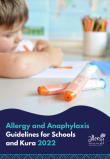- Most food allergies start in childhood.
- Most allergic reactions to food cause mild to moderate symptoms such as a rash or an upset tummy. But in rare cases, you can have a severe reaction called anaphylaxis.
- Avoiding the food is the only way to prevent an allergic reaction.
- Not all bad reactions to foods are due to allergy. They can be due to food intolerance, toxic reactions, food poisoning, enzyme deficiencies or food aversion.
- Get a diagnosis before taking any food out of your diet, as that can mean you don't get enough nutrients to stay well.
- Have an action plan and carry your adrenaline autoinjector at all times if you are at risk of anaphylaxis.
Low or no data? Visit zero.govt.nz, scroll down the page then click on our logo to return to our site and browse for free.
Food allergies
Key points about food allergies
- A food allergy is when your body’s immune system reacts to a harmless food as if it were toxic.
- A severe allergic reaction is called anaphylaxis.
- Anaphylaxis must be treated as a medical emergency, needing immediate treatment and urgent medical attention. If you or someone you care for experiences the symptoms of anaphylaxis below, give adrenaline if available and call 111 for an ambulance.
- swelling of your tongue
- tightness in your throat
- difficulty breathing or wheezing
- difficulty talking or a hoarse voice
- dizziness or collapse
- pale and floppy (in young children).

Most food allergies start in childhood. They are most common in young children under 5 years and affect up to 10% of them. Even young babies can develop symptoms of food allergy.
Food allergy is not hereditary (passed down in families), but a baby with parents who have food allergies is more likely to develop food allergy. Some babies develop food allergy even though there is no family history of it. Read more about reducing food allergies in infants.
Adult onset of food allergy is not common. Food intolerance is much more common in adults and can be due to a variety of causes. Read more about the difference between food allergy and intolerance.
Common allergy-causing foods include:
- peanuts
- tree nuts such as almonds or cashews
- milk or milk products
- eggs
- sesame seeds
- fish
- shellfish
- kiwifruit
- soy or soybean products
- wheat
- lupin.
In Aotearoa New Zealand, these ingredients must be put on food labels, even if the product only contains very small amounts.
Not all bad reactions to foods are due to allergy. They can be due to food intolerance, toxic reactions, food poisoning, enzyme deficiencies or food aversion. Symptoms of adverse reactions to foods can include headaches after having chocolate or red wine, or bloating after drinking a milkshake or eating pasta.
Symptoms of an allergic reaction to food normally develop immediately after or within hours of eating. In most cases, the allergic reaction may cause mild to moderate symptoms such as a rash or an upset tummy. In rare cases, it can cause a severe reaction called anaphylaxis.
Mild to moderate symptoms include:
- itching and hives (urticaria)
- swelling around your lips, face and eyes
- tummy pain
- diarrhoea (runny poo)
- nausea )feeling sick) or vomiting (being sick)
- sneezing.
Signs of a severe allergic reaction (anaphylaxis) include:
- swelling of your tongue
- tightness in your throat
- difficulty breathing or wheezing
- difficulty talking or hoarse voice
- dizziness or collapse
- pale and floppy (in young children).
|
Anaphylaxis must be treated as a medical emergency, requiring immediate treatment and urgent medical attention. If you or someone you care for experiences the above symptoms of anaphylaxis, give adrenaline if available and call 111 for an ambulance. |
Although allergic reactions to foods are common in New Zealand, death from anaphylaxis due to food allergy is very uncommon. The most common foods causing life-threatening anaphylaxis are peanuts, tree nuts, shellfish, milk and eggs.
Most deaths can be prevented by careful avoidance of foods you are allergic to and immediate use of an adrenaline autoinjector if you do have a severe allergic reaction.
If you are concerned your child may have a food allergy, see your GP or doctor for a diagnosis. It is important to get a reliable diagnosis of food allergy before restricting a particular food in your or your child’s diet as this can cause malnutrition. Your GP will ask you or your child about allergic symptoms such as a rash or an upset stomach, and their relation to food. It is easy to identify which food is causing the reaction when symptoms appear rapidly after eating it. However, if the cause is unknown, other diagnostic tests may be needed.
Your GP may refer you or your child for a skin prick test or a blood test to test for the presence of an antibody that causes an allergic reaction. Your doctor may also refer you or your child to a paediatric clinic or allergy specialist for further tests if it is still unclear about the cause.
Currently, there is no cure for food allergy. Avoidance of the food is the only way to prevent a reaction. This can be difficult, especially if foods are contaminated with traces of another food. Your doctor, nurse or dietitian can provide advice about avoiding food allergens.
Adrenaline is used to treat severe allergic reactions (anaphylaxis). It can be administered via an auto-injector such as an EpiPen(external link) to slow down or stop a severe allergic reaction. If you have a food allergy and are thought to be at higher risk of developing anaphylaxis, your doctor, pharmacist or nurse can teach you how to inject adrenaline using an EpiPen. You will also need to have an anaphylaxis action plan that documents what to do if you have anaphylaxis and when to call for help. Read more about anaphylaxis.
If you have a mild or moderate allergic reaction, treatment aims to relieve your symptoms. Antihistamines are the most used medicines. These relieve itching or hives on your skin. Examples include cetirizine and loratadine. You will also need to have an action plan that outlines what to do when you have an allergic reaction.
Researchers continue to explore new ways of more effectively treating food allergies. Treatment of milk and egg allergies now includes recommendations on introducing milk and egg in baked products, following a ‘ladder’, until you can safely eat the raw product. This is considered to help speed up the ‘growing out’ phase rather than desensitise the patient. However, this needs to be done as part of clinical management by a specialist and is not appropriate to all food allergy or all people.
Immunotherapy as a treatment for food allergy involves giving tiny and increasing amounts of the food protein to ‘desensitise’ the immune system to that food. Results from preliminary research into immunotherapy look promising. However this is still very much in the research phase, with a lot of unanswered questions.
Most children allergic to cow's milk, soy, wheat or egg will ‘outgrow’ their food allergy. About 80% of children eventually tolerate these foods by 5 years of age. However, peanut, tree nut, seed and seafood allergies tend to be lifelong allergies.
You can only prevent the symptoms of food allergy by avoiding the food you are allergic to. After you have identified the foods to which you are sensitive, you must remove them from your or your child’s diet.
Some of the ways to minimise your risk or your child’s risk of exposing to a particular food allergen include:
- telling others, such as restaurant staff, of your or your child’s food allergy when eating away from home
- not sharing or swapping food or utensils with others
- asking about food ingredients when offered food by others
- be aware of cross-contamination of food allergens when preparing food
- washing hands and surfaces to prevent cross-contamination
- knowing how to identify your food allergen and checking food product labels
- having a travel plan for any trips away from home – read more about travelling with food allergies
- knowing which vaccines to avoid if you or your child is allergic to egg, including the yellow fever vaccine, Q fever vaccine and the Rabipur brand of rabies vaccine – your doctor, nurse or pharmacist can provide advice and more details about these vaccines.
Reading and checking food labels
The Australia New Zealand Food Standards Code requires food labels to declare certain foods and substances in foods. If you are allergic to a certain food, try to learn the different names used to describe that food on food labels, eg:
- egg – eggs, egg albumen, egg yolk, egg lecithin
- lactose – milk, lactose
- milk – non-fat milk solids, cheese, yoghurt, caseinates, whey, lactose
- soy – soybeans, hydrolysed vegetable protein, soy protein isolate, soy lecithin.
For a complete list see the Australia New Zealand Food Standards(external link) website or Allergy New Zealand’s food allergen labelling guide(external link).
Despite your best efforts to avoid particular foods, you may be exposed to it accidentally. Be prepared for this by:
- having an allergy action plan
- carrying your adrenaline autoinjector with you at all times if you have been prescribed one
- wearing a medical alert bracelet or necklace so medical staff know how to treat you or your child in a medical emergency
- learning the signs and symptoms of mild to moderate and severe allergic reactions (anaphylaxis) and knowing what to do when a reaction occurs.
Allergy action plans
An action plan documents and outlines the steps that you can follow if you have an allergic reaction, whether it is mild or serious. If you are thought to be at risk for anaphylaxis and have been prescribed an adrenaline autoinjector you need an action plan for anaphylaxis.(external link) If you are not thought to be at high risk of anaphylaxis and have not been prescribed an adrenaline autoinjector, you need an action plan for allergic reactions.(external link)
Your doctor can discuss these plans with you and complete them with you together. They are available from the Australian Society of Clinical Immunology & Allergy (ASICA) website(external link).
Support
Allergy NZ(external link) provides information, education and support for people with allergy, parents of children with allergy, teachers and healthcare professionals.
Here are some tips to help you support your child with a food allergy:
- Avoid spreading food that is not safe for your child to eat by washing your hands and your child's hands with soap and water before handling food.
- Prepare and serve foods with clean utensils and other kitchen items and on clean surfaces.
- Teach your child how to manage their food allergies. You can start teaching your child even at a young age.
- When old enough, teach your child to read labels.
- Also teach your child how and when to use an adrenaline autoinjector, and to tell an adult if they are having an allergic reaction.
- After the diagnosis, focus on safe foods your child can have, rather than what they can't have.
- Start with plain foods with simple ingredients. From there you can look for new recipes that use safe ingredients.
- Educate family, friends and others who will be with your child about your child's allergies.
- Be sure to tell your child's school and anyone responsible for your child about his or her food allergies. See allergies – tips for children starting school.
- For children with eczema, limiting their diet to try and reduce eczema does not work and can lead to poor nutrition. It can also increase the chance of them developing food allergies. Regular use of steroid creams and moisturisers are the best way to manage eczema.
The following links provide further information about food allergies. Be aware that websites from other countries may have information that differs from New Zealand recommendations.
Food allergy(external link) Allergy NZ
Food allergen labelling guide(external link) Allergy NZ
Food allergies(external link) Ministry for Primary Industries, NZ
Food allergy(external link) The Australasian Society of Clinical Immunology and Allergy
Allergy prevention in infants(external link) The Australasian Society of Clinical Immunology and Allergy
Reducing the risk of developing food allergy(external link) Murdoch Children’s Research Institute, Australia
Resources
Allergy & anaphylaxis guidelines(external link) Allergy NZ, 2022
Action plan for allergic reactions(external link) Australasian Society of Clinical Immunology & Allergy, Australia, 2023
Action plan for anaphylaxis – for use with EpiPen adrenaline autoinjectors(external link) Australasian Society of Clinical Immunology and Allergy, Australia, 2023
English(external link), Arabic(external link) Chinese Traditional(external link) Chinese Simplified(external link)
References
- Food allergy(external link) Starship Clinical Guidelines, NZ
- Food allergy(external link) The Australasian Society of Clinical Immunology & Allergy
- Food allergy basics(external link) Allergy & Anaphylaxis Australia
- Allergen labelling(external link) Food Standards Australia and NZ
Watch this video series from a PHARMAC seminar about how to prevent paediatric food allergy and eczema held on 26 July 2017. Expert insights from Dr Diana Purvis (Paediatrician and Dermatologist, Starship Hospital and Private Practice) & (Dr Jan Sinclair Paediatrician, Starship Hospital).
See our page Food allergy for healthcare providers
Brochures

Australasian Society of Clinical Immunology & Allergy, Australia, 2023

Australasian Society of Clinical Immunology and Allergy, Australia, 2023
English, Arabic, Chinese Traditional, Chinese Simplified

Allergy NZ, 2022
Credits: Healthify editorial team. Healthify is brought to you by Health Navigator Charitable Trust.
Last reviewed:
Page last updated:





